�
Thank you for purchasing the Minolta DiMAGE E201. Please take the time to read
through this instruction manual so you can enjoy all the features of your new camera.
This manual contains information regarding products introduced before May, 2001. To
obtain compatibility information for products released after this date, contact a Minolta
Service Facility listed on the back cover of this manual.
This mark on your camera certifies that this camera
meets the requirements of the EU (European Union)
concerning interference causing equipment
regulations.
CE stands for Conformité Européenne (European
Conformity).
This device complies with Part 15 of the FCC Rules.
Operation is subject to the following two conditions:
(1) This device may not cause harmful interference,
and (2) this device must accept any interference
received, including interference that may cause
undesired operation.
Tested by the Minolta Corporation
101 Williams Drive, Ramsey, New Jersey 07446,
U.S.A.
Digital Camera:
Tested To Comply
With FCC Standards
FOR HOME OR OFFICE USE
This Class B digital apparatus complies with Canadian ICES-003.
Cet appareil numérique de la classe B est conforme à la norme NMB-003 du Canada.
Do not remove the ferrite cores from the cables.
BEFORE YOU BEGIN
Check the packing list before using the product. If any parts are missing, contact
your local camera dealer or a Minolta Service Facility listed on the back cover of this
manual.
1 Minolta DiMAGE E201 Digital Camera
4 AA Alkaline Batteries
1 Camera Strap
1 Camera Case
1 8MB CompactFlash Card
1 Video Cable
1 USB Cable
1 CD-ROM for DiMAGE E201
1 Adobe PhotoDeluxe Home Edition 4.0 CD-ROM (Windows)
1 Adobe PhotoDeluxe 2.0 CD-ROM (Macintosh)
1 Instruction Manual
1 Warranty Card
The DiMAGE E201 CD-ROM includes Windows and Macintosh versions of Quick
Time 4.1 and the DiMAGE E201 Exif Utility as well as USB drivers for Windows 98,
98SE, ME, and 2000 Professional.
Apple, the Apple logo, Macintosh, Power Macintosh, Mac OS, and the Mac OS logo are
registered trademarks of Apple Computer Inc. Microsoft and Windows are registered
trademarks of the Microsoft Corporation. The official name of Windows® is Microsoft
Windows Operating System. Pentium is a registered trademark of the Intel Corporation.
Adobe and PhotoDeluxe are registered trademarks of Adobe Systems Inc. QuickTime is a
trademark used under license. PowerPC is a trademark of International Business
Machines Corporation. All other trademarks are the property of their respective owners.
- 2-
- 3-
FOR PROPER AND SAFE USE
Read and understand all warnings and cautions before using this product.
WARNING
Using batteries improperly can cause them to leak harmful solutions, overheat, or
explode which may damage property or cause personal injury. Do not ignore the
following warnings.
• Only use the batteries specified in this instruction manual.
• Do not install the batteries with the polarity (+/–) reversed.
• Do not use batteries which show wear or damage.
• Do not expose batteries to fire, high temperatures, water, or moisture.
• Do not attempt to short or disassemble batteries.
• Do not store batteries near or in metallic products.
• Do not mix batteries of different types, brands, ages, or charge levels.
• Do not charge alkaline batteries.
• When recharging rechargeable batteries, only use the recommended charger.
• Do not use leaking batteries. If fluid from the batteries enters your eye, immediately
rinse the eye with plenty of fresh water and contact a doctor. If fluid from the batteries
makes contact with your skin or clothing, wash the area thoroughly with water.
• Use only the specified AC adapter within the voltage range indicated on the adapter
unit. An inappropriate adapter or current may cause damage or injury through fire or
electric shock.
• Do not disassemble this product. Electric shock may cause injury if a high voltage
circuit inside the product is touched.
• Immediately remove the batteries or unplug the AC adapter and discontinue use if the
camera is dropped or subjected to an impact in which the interior, especially the flash
unit, is exposed. The flash has a high voltage circuit which may cause an electric
shock resulting in injury. The continued use of a damaged product or part may cause
injuries or fire.
• Keep batteries or small parts that could be swallowed away from infants. Contact a
doctor immediately if an object is swallowed.
• Store this product out of reach of children. Be careful when around children, not to
harm them with the product or parts.
• Do not fire the flash directly into the eyes. It may damage eyesight.
• Do not fire the flash at vehicle operators. It may cause a distraction or temporary
blindness which may lead to an accident.
• Do not use the monitor while operating a vehicle or walking. It may result in injury or
an accident.
• Do not look directly at the sun or strong light sources through the viewfinder. It may
damage your eyesight or cause blindness.
• Do not use this product in a humid environment, or operate this product with wet
hands. If liquid enters the product, immediately remove the batteries or unplug the AC
adapter and discontinue use. The continued use of a product exposed to liquids may
cause damage or injury through fire or electric shock.
• Do not use the product near inflammable gases or liquids such as gasoline, benzine,
or paint thinner. Do not use inflammable products such as alcohol, benzine, or paint
thinner to clean the product. The use of inflammable cleaners and solvents may
cause an explosion or fire.
• When unplugging the AC adapter, do not pull on the power cord. Hold the adapter
unit when removing it from an outlet.
• Do not damage, twist, modify, heat, or place heavy objects on the AC adapter cord. A
damaged cord may cause damage or injury through fire or electric shock.
• If the product emits a strange odor, heat, or smoke, discontinue use. Immediately
remove the batteries taking care not to burn yourself as batteries become hot with
use. The continued use of a damaged product or part may cause injuries.
• Take the product to a Minolta Service Facility when repairs are required.
CAUTION
• Do not use or store the product in a hot or humid environment such as the glove
compartment or trunk of a car. It may damage the product and batteries which may
result in burns or injuries caused by heat, fire, explosion, or leaking battery fluid.
• If batteries are leaking, discontinue use of the product.
• The camera temperature rises with extended periods of use. Care should be taken to
avoid burns.
• Burns may result if the CompactFlash card or batteries are removed immediately
after extended periods of use. Turn the camera off and wait for it to cool.
• Do not fire the flash while it is in contact with people or objects. The flash unit
discharges a large amount of energy which may cause burns.
• Do not apply pressure to the LCD monitor. A damaged monitor may cause injury, and
the liquid from the monitor may cause inflammation. If liquid from the monitor makes
contact with skin wash the area with fresh water. If liquid from the monitor comes in
contact with the eyes, immediately rinse the eyes with plenty of water and contact a
doctor.
• When using the AC adapter, insert the plug securely into the electrical outlet.
• Do not use if the AC adapter cord is damaged.
• Do not cover the AC adapter. A fire may result.
• Do not obstruct access to the AC adapter; this can hinder the unplugging of the unit
in emergencies.
• Unplug the AC adapter when cleaning or when the product is not in use.
- 4-
- 5-
�
TABLE OF CONTENTS
ABOUT THIS MANUAL
Icons have been placed at the top of the page for quick reference. The icons indicate
if the camera is on or off, the mode the camera should be in, and the position of the
function dial. Special warnings are placed in dark gray boxes within the text.
The first circular icon indicates that the lens cover should be
open. The second shows the camera is in recording mode.
The first circular icon indicates that the lens cover should be
closed. The second shows the camera is in playback mode
and the LCD monitor needs to be activated with the
display/enter button.
This icon indicates the position of the function dial.
NAMES OF PARTS
CAMERA BODY...........................................................................10
VIEWFINDER...............................................................................12
FUNCTION DIAL..........................................................................12
DATA PANEL................................................................................13
GETTING UP AND RUNNING........................................................14
CONSERVING BATTERY POWER .............................................14
INSERTING THE BATTERIES AND COMPACTFLASH CARD...15
HANDLING THE CAMERA ..........................................................15
TURNING ON THE CAMERA......................................................15
TAKING PICTURES (Recording Mode).......................................16
VIEWING PICTURES (Playback Mode) ......................................17
DELETING IMAGES ....................................................................18
SETTING UP THE CAMERA ..........................................................19
CHANGING BATTERIES .............................................................20
BATTERY-POWER INDICATORS................................................21
AUTO POWER OFF.....................................................................21
USING THE AC ADAPTER (Sold Separately).............................22
ATTACHING THE CAMERA STRAP ...........................................22
INSERTING THE COMPACTFLASH CARD ................................23
REMOVING THE COMPACT FLASH CARD ...............................24
TAKING PICTURES .........................................................................25
SETTING THE CAMERA IN RECORDING MODE......................26
LCD MONITOR DISPLAY (Recording Mode) ..............................26
BASIC RECORDING OPERATION..............................................27
FOCUS LOCK..............................................................................28
FOCUS LAMP/NO FOCUS INDICATOR .....................................28
SPECIAL FOCUSING SITUATIONS............................................29
FOCUS RANGE...........................................................................29
FLASH MODES ...........................................................................30
CHANGING THE FLASH MODE .................................................31
FLASH LAMP...............................................................................32
FLASH RANGE............................................................................32
CLOSE-UP PHOTOGRAPHY (Macro Mode) ..............................32
EXPOSURE COMPENSATION ...................................................34
DIGITAL ZOOM............................................................................36
FUNCTION DIAL AND RECORDING MODES............................37
MOVIE MODE..............................................................................38
MOVIE-MODE DISPLAYS ...........................................................39
CONTINUOUS-ADVANCE MODE ...............................................40
SELF-PORTRAITS (Self-timer)....................................................41
IR REMOTE CONTROL (Sold Separately)..................................42
RECORDING-MODE MENU (Controlling the Image)..................43
NAVIGATING THE RECORDING-MODE MENU.........................44
IMAGE QUALITY .........................................................................46
IMAGE SIZE.................................................................................47
IMAGE-FILE SIZE........................................................................47
WHITE BALANCE........................................................................48
SHARPNESS ...............................................................................49
CAMERA SENSITIVITY (ISO) .....................................................49
COMPACTFLASH CARD CAPACITY ..........................................50
- 6-
- 7-
�
CONNECTING TO A COMPUTER.................................................76
SOFTWARE SYSTEM REQUIREMENTS ...................................77
CONNECTING THE CAMERA TO A COMPUTER......................78
CONNECTING TO WINDOWS ME .............................................79
CONNECTING TO WINDOWS 2000 PROFESSIONAL..............80
CONNECTING TO WINDOWS 98...............................................82
CONNECTING TO A MACINTOSH .............................................83
COMPACTFLASH CARD ORGANIZATION.................................84
DiMAGE E201 EXIF UTILITY ......................................................85
DISCONNECTING THE CAMERA FROM THE COMPUTER .....86
APPENDIX.........................................................................................88
TROUBLESHOOTING ..................................................................89
CARE AND STORAGE .................................................................92
TECHNICAL SPECIFICATIONS ...................................................95
TABLE OF CONTENTS
VIEWING PICTURES (Playback Mode) ........................................51
SINGLE-FRAME PLAYBACK.......................................................52
INDEX PLAYBACK.......................................................................53
TURNING OFF THE CAMERA IN PLAYBACK MODE ................54
ENLARGED PLAYBACK..............................................................54
SLIDE SHOW...............................................................................56
NAVIGATING THE SLIDE-SHOW MENU ....................................56
MOVIE PLAYBACK......................................................................58
VIEWING IMAGES ON A TELEVISION.......................................60
EDITING IMAGES ............................................................................61
DISPLAYING IMAGES TO BE DELETED, LOCKED, OR UNLOCKED..........62
DELETING SINGLE IMAGES ......................................................62
LOCKING AND UNLOCKING SINGLE IMAGES.........................63
NAVIGATING THE PLAYBACK MENU ........................................64
DELETE ALL................................................................................66
LOCK ALL ....................................................................................66
UNLOCK ALL...............................................................................66
PRINTING IMAGES .....................................................................67
PRINTING FORMAT ....................................................................67
PRINT-ORDER MENU.................................................................68
SET ORDER ................................................................................68
PRINT ALL ...................................................................................69
CANCEL ALL ...............................................................................69
SETUP MODE...................................................................................71
NAVIGATING THE SETUP MENU...............................................72
LCD MONITOR BRIGHTNESS....................................................74
FORMATTING A COMPACTFLASH CARD.................................74
SETTING AUTO-POWER-OFF PERIOD.....................................74
SETTING THE DATE AND TIME .................................................74
BEEP............................................................................................75
SETTING THE VIDEO-OUT SIGNAL ..........................................75
RETURNING TO THE DEFAULT SETTINGS..............................75
- 8-
- 9-
�
NAMES OF PARTS
CAMERA BODY
* This camera is a sophisticated optical instrument. Care should be taken to keep these
surfaces clean. Please read the care and storage instructions in the back of this
manual (p. 92).
Function dial
Self-timer lamp
Data panel*
Viewfinder
window*
Flash*
Lens-cover slide
Lens*
Flash
sensor*
DC terminal
IR remote-control receiver*
Video-out terminal
Battery/Card chamber door
Tripod socket
Underside of Body
Digital-zoom button
(Digital-zoom recording p. 36)
(Enlarged playback p. 54)
Viewfinder*
Exposure-compensation/Lock button
Flash-mode/Delete button
Shutter-release button
Strap
eyelet
USB port*
LCD monitor*
Menu button
Display/Enter button
Scroll-up button
Scroll-down button
- 10-
- 11-
�
NAMES OF PARTS
VIEWFINDER
Image frame
Focus frame
DATA PANEL
The following diagram displays all icons on the panel to aid explanation.
Flash-mode indicators p. 30
Self-timer/Remote control indicator p. 41
Manual white-balance indicator p. 48
Exposure-compensation indicator p. 34
Battery-condition indicator p. 21
Sharpness indicator p. 49
Image-quality indicators p. 46
Focus lamp (green)
Steady:
Blinking quickly:
Blinking slowly:
focus confirmed and locked.
cannot focus (p. 28).
an image is being trans-
ferred between the camera
and CompactFlash card or a
movie clip is being recorded.
Flash lamp (orange)
Steady:
Blinking: flash is charging and the shutter is locked.
flash charged and ready to fire.
FUNCTION DIAL
• The dial is used for quick and simple
access to the camera’s major functions.
Movie recording (p. 38)/
Movie playback (p. 58)
Setup mode (p. 71)
Continuous advance (p. 40)/
Index playback (p. 53)
Single-frame advance (p. 27)/
Single-frame playback (p. 52)
Self-timer/Remote control (p. 41)/
Slide show (p. 56)
This area of the panel is used for the following:
• Frame counter* p. 50
• Exposure-compensation display p. 34
• No CompactFlash card indicator p. 23
* The frame counter will indicate the approximate number of images that can be be
stored on the CompactFlash card in the selected image quality or size modes; if a
mode is changed, the frame counter will adjust accordingly on the data panel.
When in the movie-recording mode, the data panel will indicate the number of one-
minute movie clips that can be recorded on the CompactFlash card; “C” is used as
the abbreviation for clip. When less than one 60-second clip can be stored, the
counter will indicate the number of remaining seconds. When recording, the data
panel counter will countdown from 60 seconds or from the remaining time when less
than one clip can be recorded.
PC mode (p. 76)
- 12-
- 13-
�
GETTING UP AND RUNNING
INSERTING THE BATTERIES AND COMPACTFLASH CARD
Open the battery/card chamber
door and insert the batteries.
• Take care to match the positive and negative
battery terminals with the indicators on the
battery/card chamber door.
Insert the CompactFlash card.
• Insert the card so the face is toward the
back of the camera.
• Always push the card in straight, never at an
angle.
• Never force the card. If the card does not fit,
check its orientation.
HANDLING THE CAMERA
Grip the camera firmly with your right hand while supporting
the body with your left hand. Keep your elbows at your side
and your feet shoulder-width apart to hold the camera steady.
Take care not to cover the lens with your fingers. Keep the
camera strap around your wrist in the event that you drop the
camera.
TURNING ON THE CAMERA
Move the lens cover slide to
to open the lens cover and turn
on the camera.
• The LCD monitor on the back of the
camera will automatically activate.
GETTING UP
AND RUNNING
This quick reference guide covers the basic operation of the cam-
era so it can be used as soon as possible. However, it is recom-
mended that the entire manual be read to properly operate the
camera and achieve the best results.
• Conserving Battery Power
• Inserting the Batteries and CompactFlash Card
• Handling the Camera
• Turning On the Camera
• Taking Pictures
• Viewing Pictures
• Deleting Images
CONSERVING BATTERY POWER
For long periods of use, or when traveling, battery
power can be conserved by turning off the LCD
monitor and using the viewfinder to take pictures.
Press the display/enter button to turn the monitor
off. It can be turned on again by pressing and hold-
ing the display/enter button for about one second.
- 14-
- 15-
�
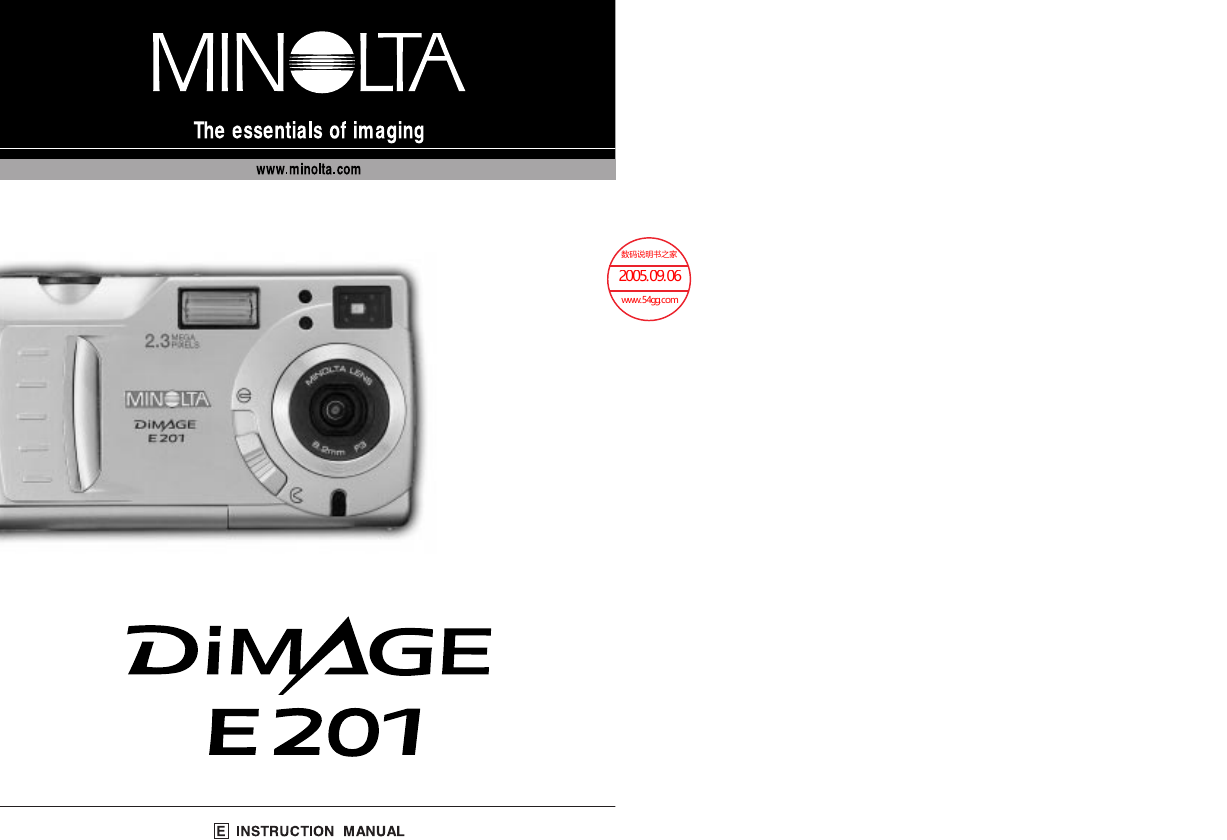
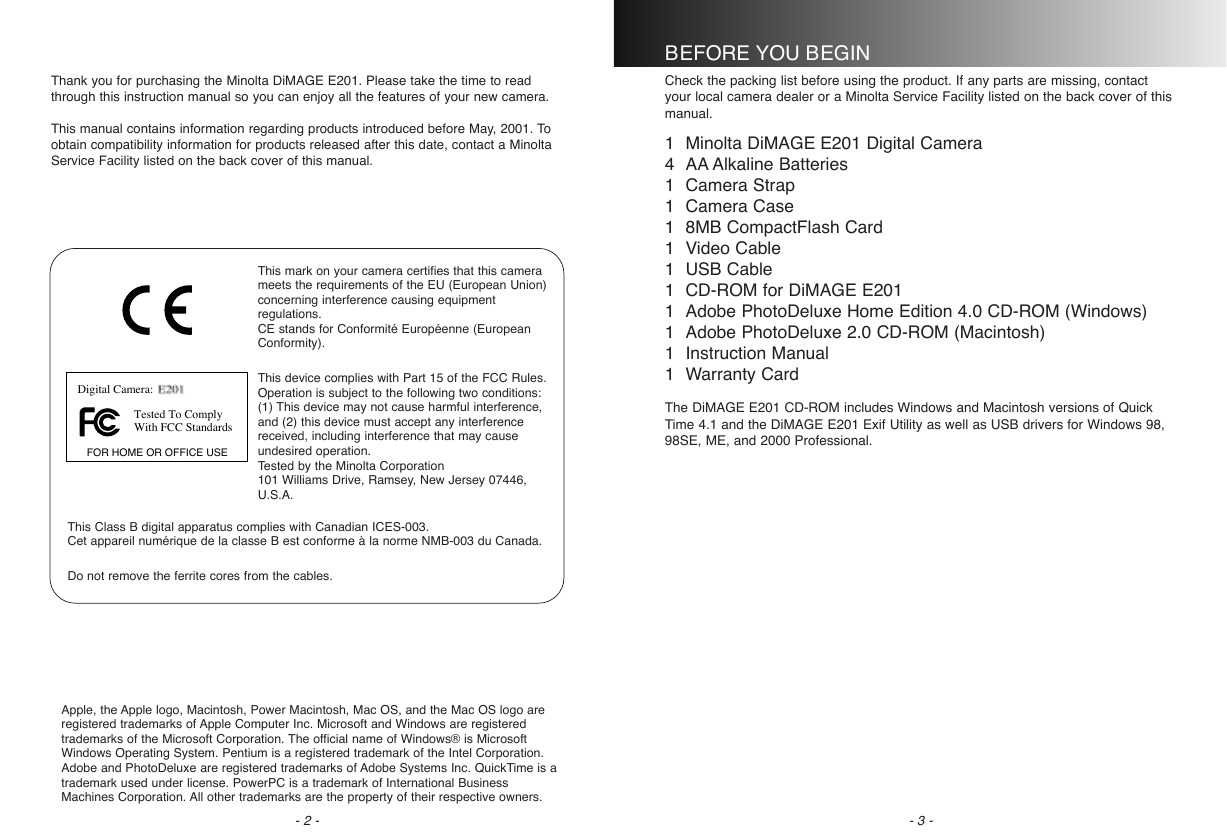
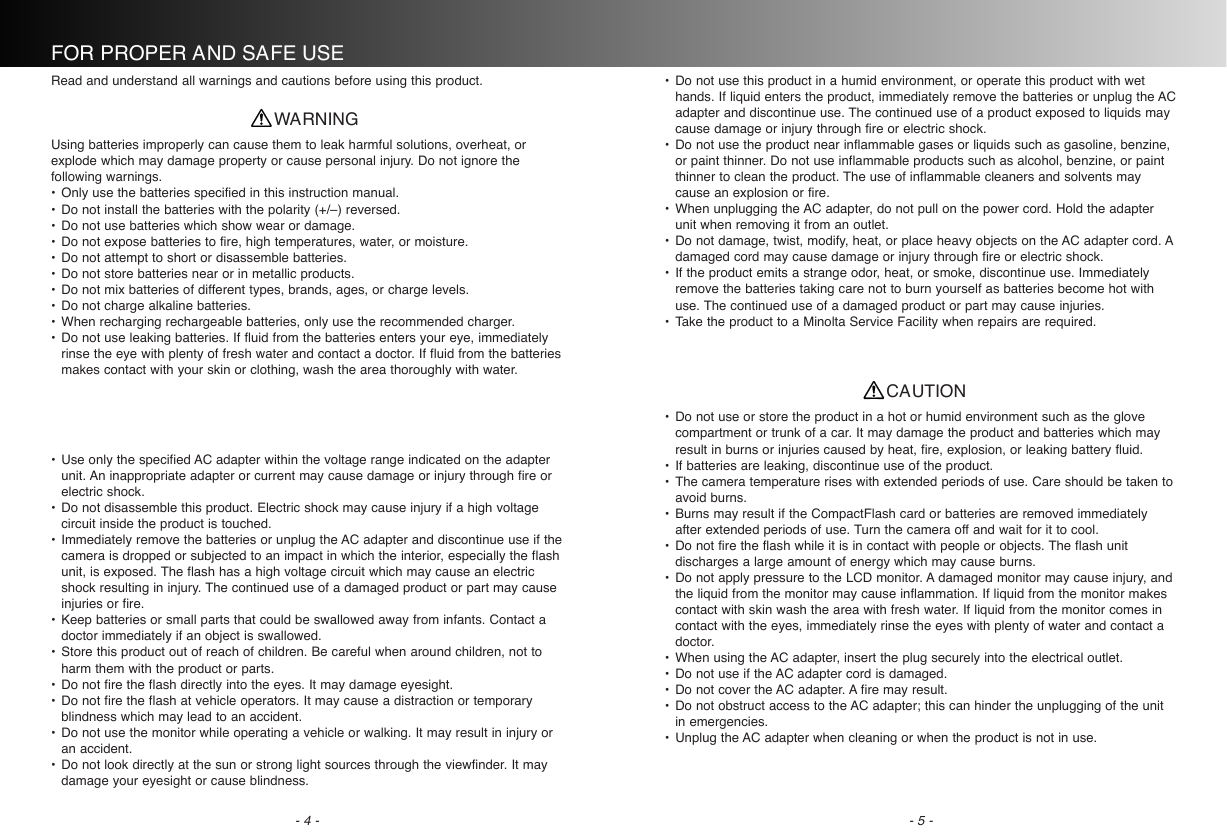
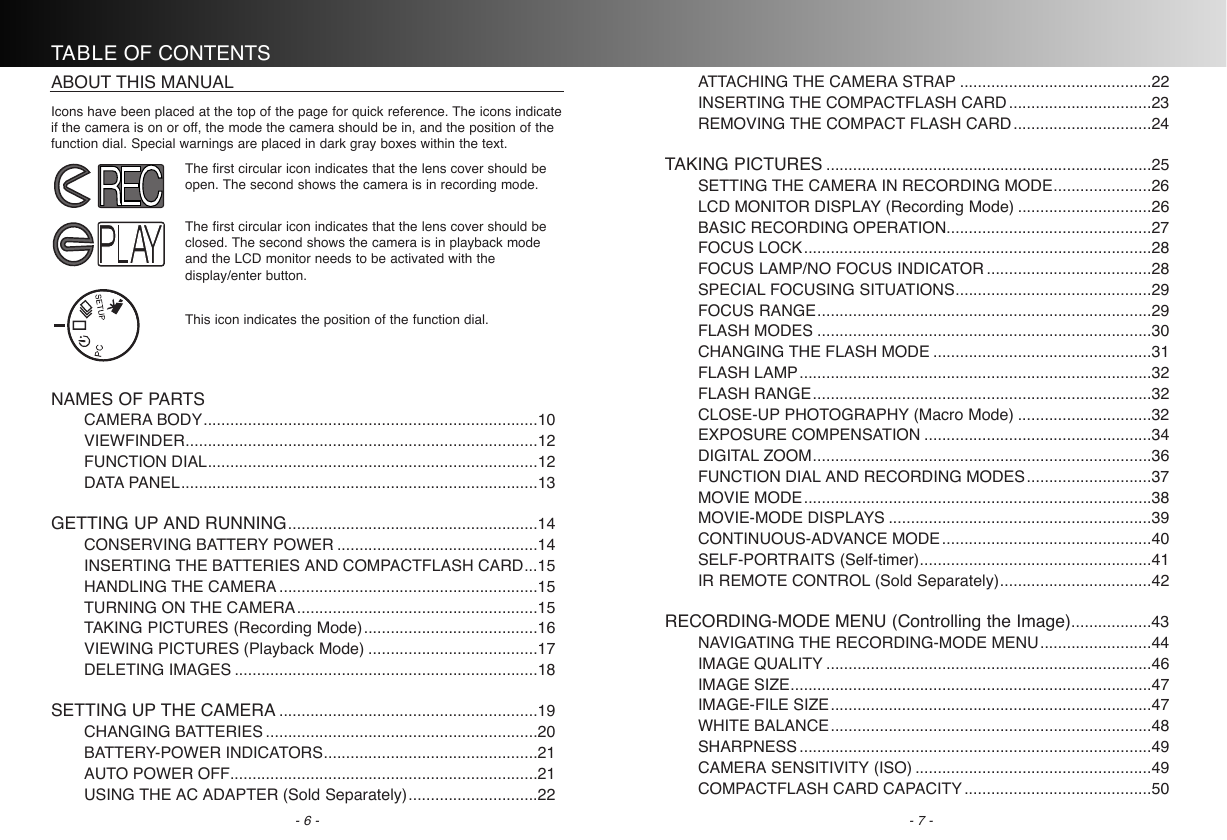
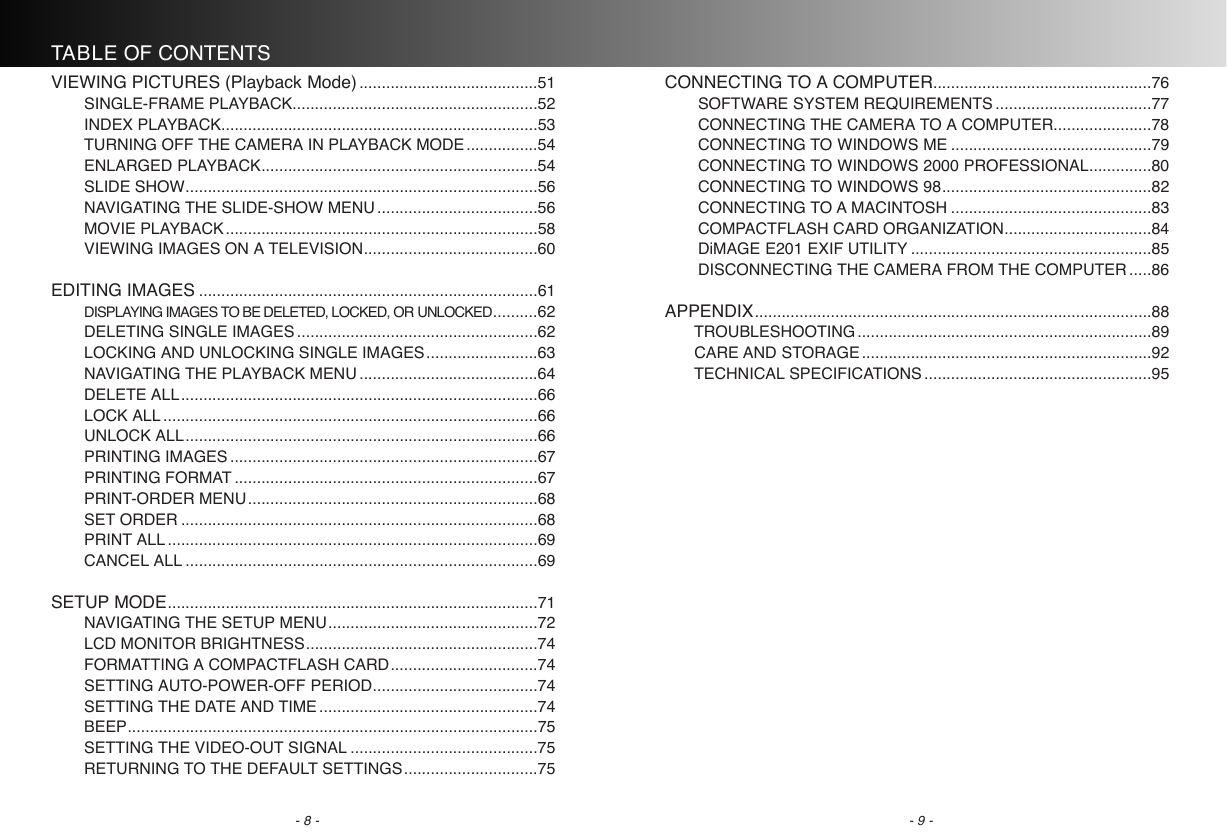
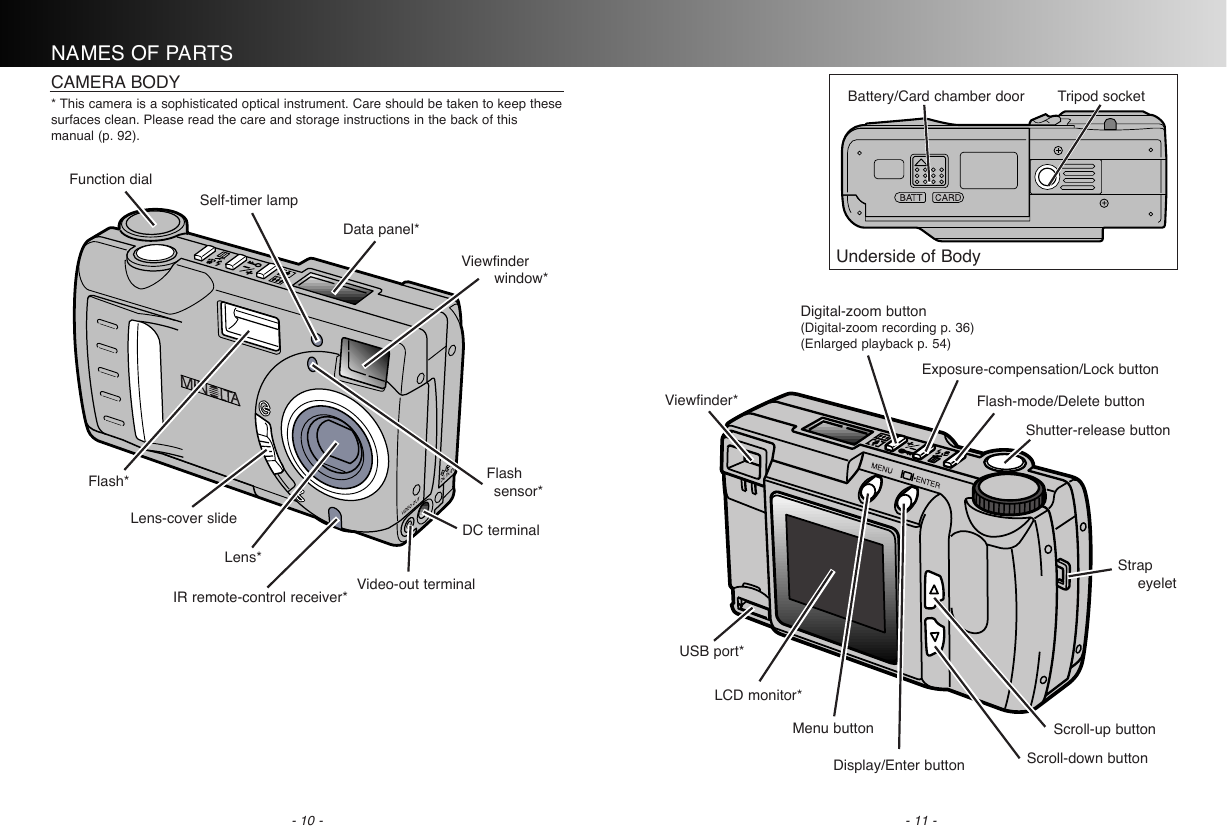
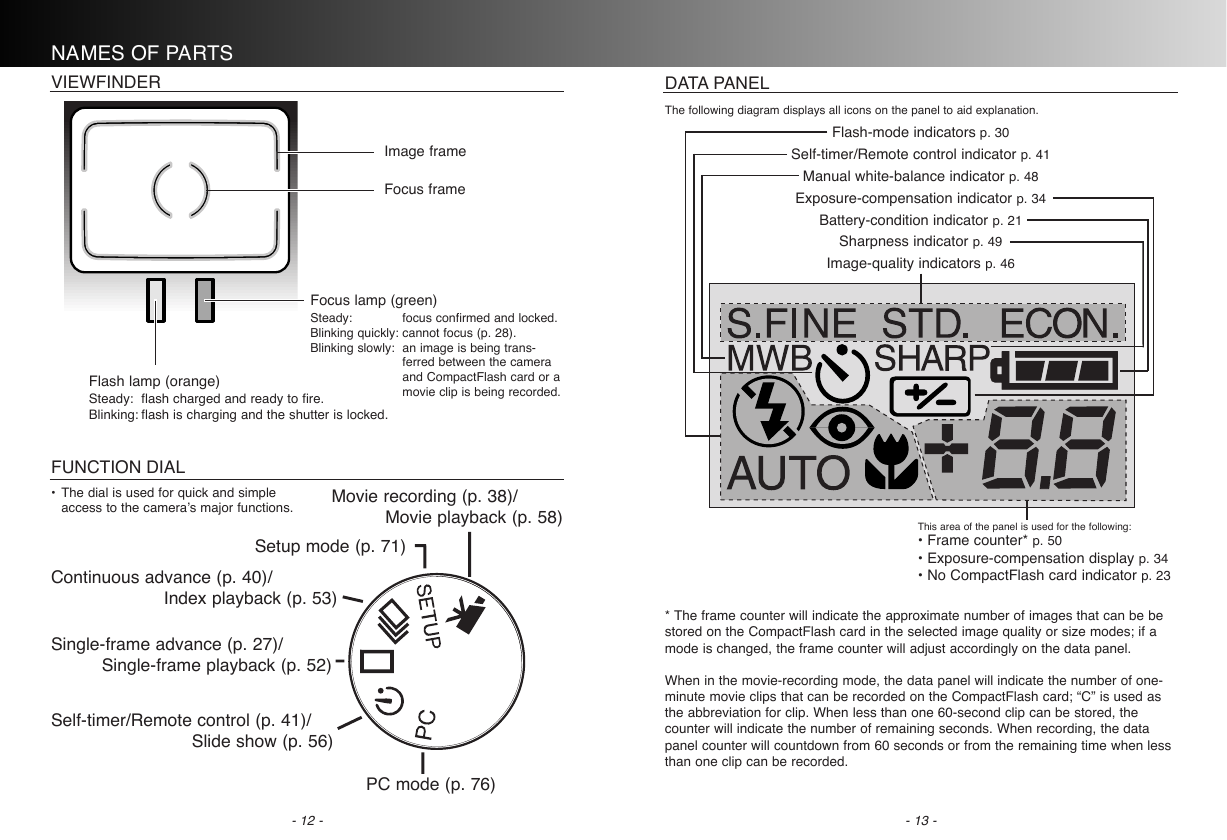
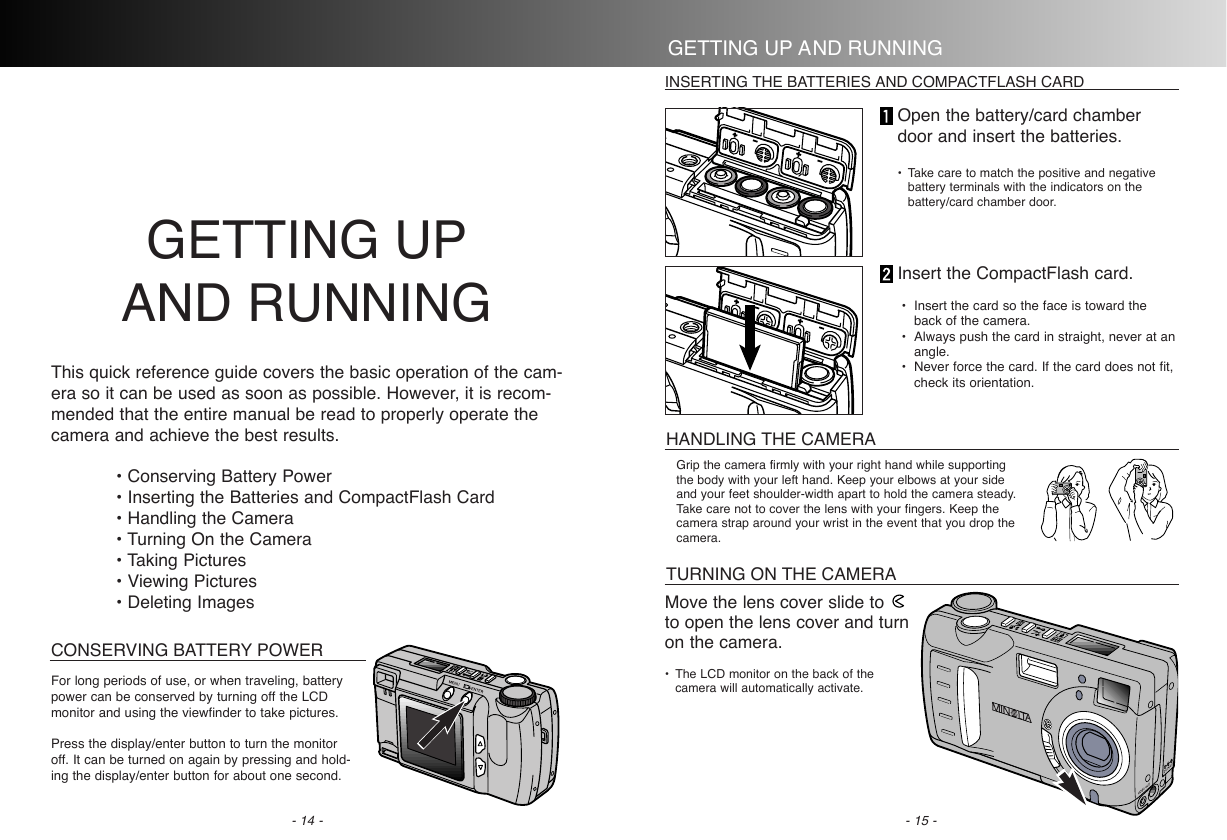








 2023年江西萍乡中考道德与法治真题及答案.doc
2023年江西萍乡中考道德与法治真题及答案.doc 2012年重庆南川中考生物真题及答案.doc
2012年重庆南川中考生物真题及答案.doc 2013年江西师范大学地理学综合及文艺理论基础考研真题.doc
2013年江西师范大学地理学综合及文艺理论基础考研真题.doc 2020年四川甘孜小升初语文真题及答案I卷.doc
2020年四川甘孜小升初语文真题及答案I卷.doc 2020年注册岩土工程师专业基础考试真题及答案.doc
2020年注册岩土工程师专业基础考试真题及答案.doc 2023-2024学年福建省厦门市九年级上学期数学月考试题及答案.doc
2023-2024学年福建省厦门市九年级上学期数学月考试题及答案.doc 2021-2022学年辽宁省沈阳市大东区九年级上学期语文期末试题及答案.doc
2021-2022学年辽宁省沈阳市大东区九年级上学期语文期末试题及答案.doc 2022-2023学年北京东城区初三第一学期物理期末试卷及答案.doc
2022-2023学年北京东城区初三第一学期物理期末试卷及答案.doc 2018上半年江西教师资格初中地理学科知识与教学能力真题及答案.doc
2018上半年江西教师资格初中地理学科知识与教学能力真题及答案.doc 2012年河北国家公务员申论考试真题及答案-省级.doc
2012年河北国家公务员申论考试真题及答案-省级.doc 2020-2021学年江苏省扬州市江都区邵樊片九年级上学期数学第一次质量检测试题及答案.doc
2020-2021学年江苏省扬州市江都区邵樊片九年级上学期数学第一次质量检测试题及答案.doc 2022下半年黑龙江教师资格证中学综合素质真题及答案.doc
2022下半年黑龙江教师资格证中学综合素质真题及答案.doc